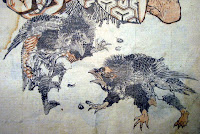I Tengu are some of the most famous bakemono (monsters) that populate the 'imaginary Japanese folklore. Usually located in forests, they are described in different ways, a tengu can appear in myths such as:

- A normal human being.
- A man of enormous nose, or too long to be real.
- A winged man and / or a squat bird's beak.
- A hybrid human / bird with hands and feet with claws.
- A bird itself (it tratterrebbe di un caso assai raro).
- Vari ibridi dati dalla combinazione delle forme sopra elencate.
 addition, the tengu were considered the best martial arts teachers , so that several students climbed the mountains in search of them, hoping to learn the magical arts, or those of the finest fighting. Especially the ninja skills was associated with the tengu, but they could also learn techniques ladies, and some warriors assigned, or given saw, the origin of proprie abilità agli insegnamenti di un maestro tengu. Per esempio, tradizione vuole che il noto fratello di Minamoto Yoritomo , Minamoto Yoshitsune , eroe militare del XII secolo, abbia appreso l'arte della spada da bambino da un vecchio e saggio tengu incontrato nella foresta.
addition, the tengu were considered the best martial arts teachers , so that several students climbed the mountains in search of them, hoping to learn the magical arts, or those of the finest fighting. Especially the ninja skills was associated with the tengu, but they could also learn techniques ladies, and some warriors assigned, or given saw, the origin of proprie abilità agli insegnamenti di un maestro tengu. Per esempio, tradizione vuole che il noto fratello di Minamoto Yoritomo , Minamoto Yoshitsune , eroe militare del XII secolo, abbia appreso l'arte della spada da bambino da un vecchio e saggio tengu incontrato nella foresta. Per quanto riguarda le notizie sulle origini dei tengu, anch'esse cambiano nel tempo: talvolta queste creature sono il risultato della trasformazione di uomini , in genere preti buddhisti o shintioisti, che erano stati maledetti dai loro pari a causa di alcuni difetti; in altri casi, sono invece descritti come semidei , demoni o razze di mostri del tutto separate dagli humans. The legends attest to the latter version often speak of tengu nests, hidden with great care on the highest mountains and filled with enormous eggs. The female tengu is rarely mentioned and sometimes it is so different from the male that the two are easily confused into two distinct species.

In addition to popular folklore, the figure of tengu is also found in religious mythology. For example, the Buddhist cosmology, appears as the tengu a rather simple-minded demon who has a single purpose: to distract the faithful from their spiritual journey. In addition, especially in the past were very common in real cults shrines tengu ; equally widespread was the practice of wearing a tengu mask during a religious pilgrimage, among other things, this mask was used in the tragedy of the No theater and still it can often be found hanging on the wall of bars and restaurants typically Japanese.
Text freely translated and processed from the web page http://www.jh-author.com/tengu.htm .